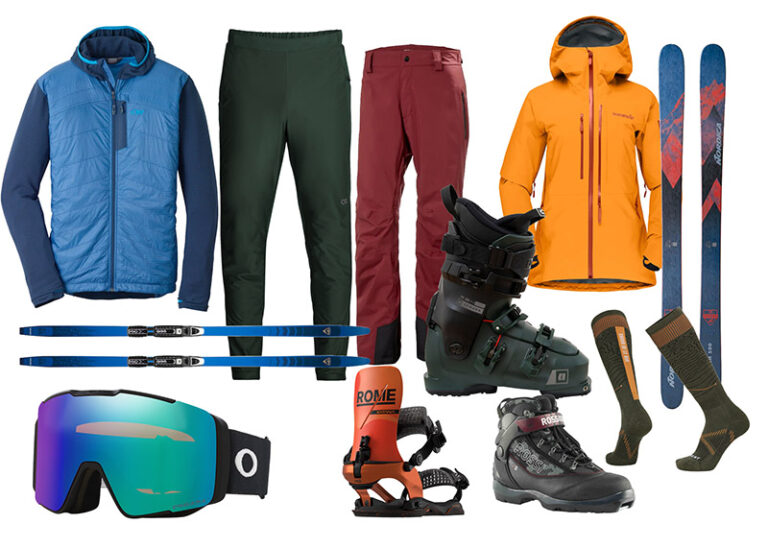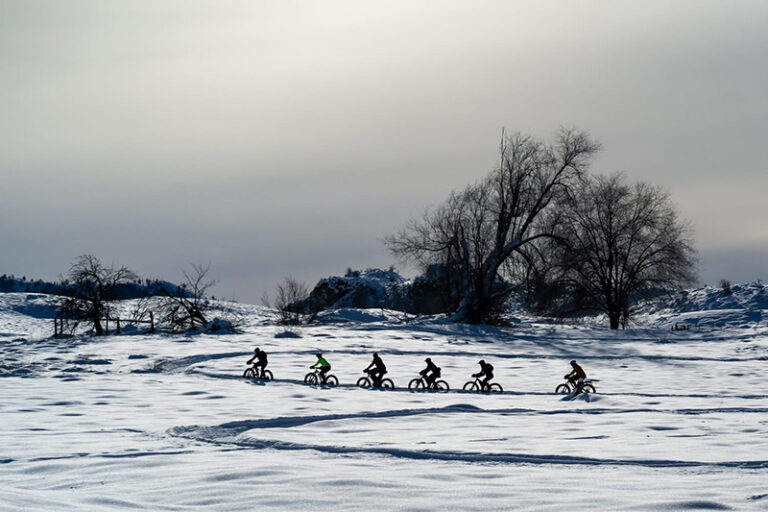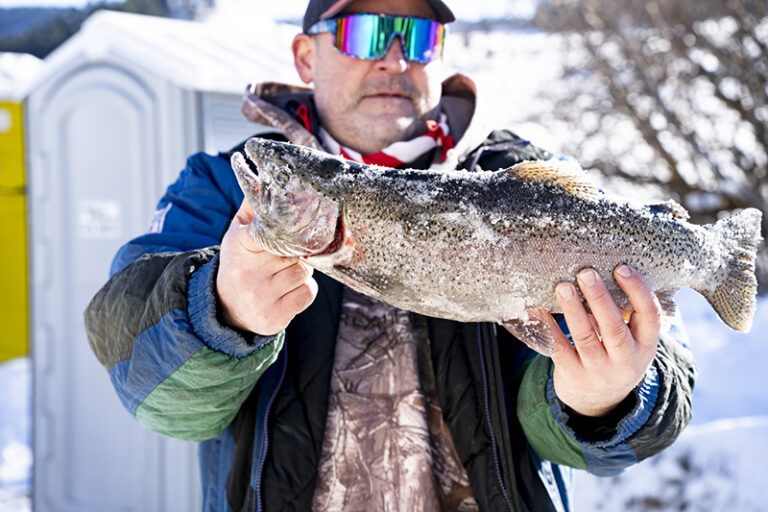SEAL MORGAN’S DAD PROMISED to buy him a new surfboard if he cut off his ponytail. The year was 1969. Morgan was 15 years old and obliged the compromise. But he hasn’t cut his hair since then.
A self-proclaimed “old guy,” Morgan was a skater, surfer and snowboarder long before the collective conscience fell in love with alternative sports. His house is full of memorabilia and looks like a hybrid skate shop. Vintage skateboarding magazines from the 1970s pile on tabletops.
Along the walls of his home in Springdale, Washington, hang vintage snowboards, skateboards and surfboards. His excitable eyes and memories of the glory days makes him part historian, part surf bum. It’s only his Yosemite Sam mustache and long silver hair that reveal his age.
“I’m an old surfer to the end,” Morgan says. “Back then, we were doing cutting edge stuff. There wasn’t a whole lot of us doing it in the 1970s, and I never thought something like snowboarding would get this big. But we were in the middle of it. We didn’t realize the ramifications. We were just riding.”
SURFING THE SNOW
Morgan grew up in Mission Beach San Diego, just 50 feet away from the ocean. By 1963, he picked up a skateboard, and soon after took to the waves on a surfboard. “I was pretty much rat packing with all the rest of the local beach kids,” he says. “The beach and the boardwalk were our focus. Our whole world was the ocean.”
But in 1972 his rat pack was introduced to a new toy called a Snurfer in Surfer Magazine. The idea was too good to pass up and as surfers will readily admit, they’ll try anything. “Surfing on the snow? Bang—that grabbed us right there,” Morgan says. “Surfer Magazine was kinda like our Bible and here it was advertising a new sport.”
That same year, Morgan bought the Snurfer Super Racing Model. The snowboard cost him about $35, but it didn’t work.
The wood snowboard slid downhill but was impossible to maneuver with a rope leash for steering and no bindings for his five-pound pair of Sorel Pac Boots. “Back then it was all experimental, we didn’t know what we were doing,” he says.
Like a mad scientist, Morgan was addicted to perfecting the experiment. His passion fueled a lifelong love of the sport, and he has spent the last 38 years shredding on the latest and greatest models, helping carve out the history of snowboarding.
His impressive snowboard collection consists of more than 60 different boards from every era until the early 1990s. “I have a museum basically,” Morgan says. That’s almost true, but his collection pales in comparison to the Utah Snowboard Museum (see sidebar), which is home to the world’s largest collection of vintage snowboards. Its owners have unsuccessfully tried to buy a few of Morgan’s boards.
“I don’t collect them for money, you know,” he says. Here are a dozen of his most unique, vintage snowboards with comments from Morgan.
SNURFING
Snowboarding was called snurfing in the mid-1960s. The sport stemmed from surfer junkies who built wooden boards, or used chopped up surfboards, to surf the snow. The 1960’s pioneers fought long and hard to claim their piece of fame and history within the sport, but snowboarding actually originated in the early 1900s.
“People were building the first Snurfers around 1912 in the Midwest,” Morgan says. “These bunker boards were made from the curved staves of whiskey barrels. People rode standing sideways with a rope on the front.”
Morgan describes imagery of men in top hats and smoking pipes propelling themselves across the mild slopes of the Midwest. Film footage from as early as 1939 shows people riding similar boards, but it wasn’t until 1965 that a man named Sherman Poppen built the Poppen’s Snurfer and founded the industry.
“Poppen built the first commercial snowboard for his daughter and then sold the patent to the Brunswick Company,” Morgan says. “Then suddenly they were doing advertising, which wasn’t happening before. Suddenly the board was in Surfer Magazine and it was in all the surf shops. You gotta find your market, and they knew it had to be skaters and surfers.”
A string of competitive Snurfers hit the market throughout the late 1960s and into the early 1970s. Then a man named Dimitrije Milovich dropped out of Cornell University in 1972 and started Winterstick, the first modern snowboard company. This Salt Lake City company dominated the mid-1970s market with their powder riders. “The Snurfers were obsolete when Winterstick came around,” Morgan says. “Their boards worked so much better.”
While Winterstick boards dominated the powder and pushed their way into international markets, a man named Jake Burton was busy making wooden snowboards in his garage in Vermont. A successful marketer, he established a line of wooden boards in the late 1970s and early 1980s around the same time that skateboard icon Tom Sims started mounting skate decks to sleds. Both men persevered all the way through the 1990s and emerged as snowboarding’s leading forces on the East and West Coasts.
STICKING
The young Morgan and his motley crew of snowboarders didn’t call it snurfing. They thought the name was too hokey so they called the sport “sticking,” because the boards were made of wood.
Morgan left his beloved ocean when he was 19 years old and moved to South Lake Tahoe in 1973. “I had a 1962 Ford Galaxy that could get me back and forth up the mountains of San Diego,” he says. “I worked at IHOP as a dishwasher at night and played in the snow all day.”
The skiers hated him. Resorts and ski patrollers hated him even more. But Morgan’s crew was not only determined, they were clever. The ski hills and resorts were built on Forest Service land, which meant they couldn’t use the lifts but the mountain was open to the public.
So they hiked the backcountry to the top of the runs, sometimes in waist deep snow, with not only their snowboards but also avalanche and emergency gear.
“They couldn’t keep us off the mountain,” Morgan says. “I didn’t buy a ticket so I didn’t have to play by their rules.”
Morgan and his friends hiked the mountains from 1972 to 1987 before they were legally allowed on a chair lift. For the first few years, snowboarders were required to pass a skills test and essentially get an operator’s license to be on the slopes.
But equal access didn’t mean equal opportunity. Snowboarders fought—sometimes with their fists—to be on the mountain. They were punched in the back of the head coming down the slopes and were hit with ski poles.
“They hated us because we were different,” Morgan says. “We were out bonking off the trees and jumping boulders. We were outcasts and we were sidelined until resorts started realizing they could make money off of us.”
SNOWBOARDING EVOLVES
Surfers were the early adopters because the snowboards and riding style mimicked surfing. But by the 1990s, innovative twin tip technology made the snowboards more symmetrical. The boards were shaped like skateboards and a new era of snowboarders ushered in the modern sport that it has become.
“Bindings, boards and boots went under cataclysmic changes in the 1990s,” Morgan says. “Suddenly you could ride both ways, switch feet and spin around. Kids started riding picnic tables and rails and were doing skate moves.”
The shift in the sport was amplified by increased numbers on the slopes. Snowboarding magazines and competitions grew popular and attracted more and more people away from skis.
“People saw that you could slide a tree and that seemed way more fun than doing pretty, little figure eights down the hill,” Morgan says. The resorts were forced to embrace the new clientele, and by 1995 snowboarding had exploded across the country.
Snowboarding continues to be the fastest growing winter sport, according to Gary Deaver, longtime ski patrol director at 49° North. This claim is echoed by all the other local resorts.
As for Morgan, he is still an avid snowboarder—visiting 49° North three times a week, bombing just as fast and hard as he did nearly 40 years ago. Martial arts and a hot tub keep him limber and ready to face the slopes. His company, Mtn. Threads-Boardwarm Hats & Clothing (http://mtnthreads.com) , keeps him busy sewing micro fleece base layers and hats so that his snowboard collection will slowly but surely continue to grow.
And despite the skateboard influence, Morgan is still an old surfer. “I’ll always be a surfer,” he says. “I surf mountains. I don’t ride snowboards on the hills like the kids do. I don’t skate hills; I surf hills.”













